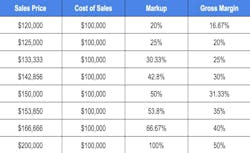Margin vs. Markup: The True Impact of Pricing Decisions on Home Builder Profits
Over the last 50-plus years of working with home builders I’ve observed what appears to be a perpetual problem: not realizing the level of profits builders should be generating from home sales.
While there are a multitude of issues that warrant discussion on this topic, one of the fundamental problems is that instead of pricing their homes for the market, builders tend to set pricing based on costs.
For example, one home builder in our network once argued that he was pricing his homes with a 25% margin on his cost, which should give him a 10% profit … but it actually only resulted in a 5% profit. His mistake was that he was multiplying $100,000 of construction costs by 125% to determine the selling price of his homes. Unfortunately, he didn’t understand the difference between margin and markup.
What Is the Difference Between Margin and Markup?
Retailers understand the difference between the margin and markup, but many home builders have a problem with the concept. Simply, a markup is a percentage added to the cost, while a margin is a percentage of the sales price.
Marking up cost by 25% yields a 20% margin on the sales price, eroding margin by 5%, which is what the builder in the example above experienced. It is the basic magic of mathematics.
Custom builders that operate on contracts with a cost-plus 10% model (which I do not recommend) yield a profit margin of just 9%, or 1% below their initial estimate.
For production builders, pricing on cost when construction costs are about 50% of the average sales price requires a 100% markup to generate a 50% margin that will also cover land, field, financing, marketing, overhead, and profit expenses. By contrast, a markup of 50% generates only a 33% margin.
Another way to calculate the appropriate margin is to divide the cost by its share of the sales price. For example, $100,000 in costs divided by 50% would equal a $200,000 sales price.
RELATED
- 5 Myths About Business Decision-Making Debunked
- Achieving Better Website Conversions, Part 1: Sales Funnel Basics
- Business Metrics and the Imagination Age of Home Building
How to Avoid Pricing Mistakes and Losing Margin
A division manager for a large, public home builder told me he was losing margin on every customer change, upgrade, or design center option due to incorrect pricing by his staff, which highlights two issues:
1.) The builder is typically getting about a 50% margin on his direct construction cost in the base sales price but is instructing the staff that he wants a 30% margin on changes, upgrades, and design selections. But with every sale, he is losing 20% on each additional item.
Here’s why: Let’s say direct construction costs for the base house are $100,000. A 50% margin (100% markup) determines a minimum sales price of $200,000 for that house to achieve that margin. But when you tack on $20,000 worth of options and upgrades (10% of minimum sales price) at a 30% margin, the sales price actually increases to $228,571 with a construction cost of $120,000. The result reduces the target margin to 47.5%, or a loss of 2.5%.
2.) The builder's staff is marking up the cost of these options and upgrades by 30%, translating to an impact on the sales price of $26,000, resulting in a margin of only 23%. Thus, while the sales price went up to $226,000, the margin on that home has now dropped to 46.9% which is a loss of 3.1% than anticipated or desired.
The lesson: Everyone responsible for pricing needs to understand the difference between margin and markup, including sales teams, purchasing and estimating personnel, and especially the design center staff.
Protect Your Profits
Home builders often give away a substantial amount of profit due to simple pricing mistakes. To protect profits, the following table should be placed on the desk of everyone responsible for pricing in a home building company.
About the Author

Charles Shinn Jr.
Charles “Chuck” C. Shinn Jr., PhD, has been dedicated to improving the management standards and profitability of the home building industry for more than 50 years. Learn more at shinnconsulting.com.

